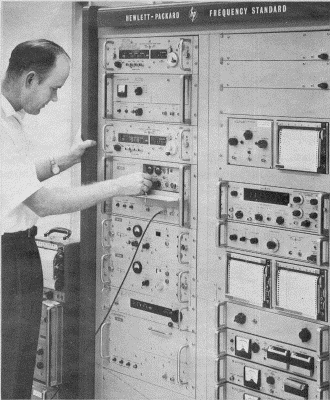THE BENCHMARK
Any of several time scales and frequency standards could have been used for the basic reference during the 1966 flying clock experiment. For convenience, the -hp- House Standard was chosen but results have shown this standard to be among the most accurate in the world and thus well-suited as a "benchmark" for time and frequency comparisons.
The basic reference within the -hp- House Standard is the -hp- Model 5060A Cesium Beam Frequency Standard shown here being checked by James Marshall, head of the Radio Frequency Section in the -hp- Measurement Standards Lab in Palo Alto, who is responsible for the -hp- House Standard. The output of the Cesium Beam Standard is compared in phase continuously against NBS Standards Stations WWVB and WWVL by the VLF Comparators at lower right. Continuous comparison since this Cesium Beam Standard was put into service last January enables its relationship to the United States Frequency Standard to be known within parts in 1012. The standard is also compared to two of the Navy VLF stations by the VLF receivers, shown to the left of the main rack.
 The clock mechanism immediately above the Cesium Standard integrates the Cesium
Standard output to show any accumulated phase error.
The clock mechanism immediately above the Cesium Standard integrates the Cesium
Standard output to show any accumulated phase error.
The house working frequency standard is the -hp- Model 107A Quartz Oscillator, immediately below the Cesium Beam Standard. This oscillator has the high short-term stability desired for a working standard and since it has been in continuous operation for three years, it has aged to the point that its drift rate is only 1 x 10-11 per day. The phases of the Quartz and Cesium Beam Standards are compared continuously by the instruments at right upper and corrections are made daily to the Quartz Standard to maintain it within 5 parts in 1012 of the Cesium Standard during working hours. The output of the quartz oscillator is distributed throughout the -hp- plant in Palo Alto.
The -hp- working time standard is the -hp- Model 106A Quartz Oscillator and the Digital Clock above the Cesium Standard. Separation of the working time and frequency standards allows corrections to be made to the working frequency standard without accounting for accumulated phase error. The working time standard is maintained within a few ms of the NBS UA time scale by continuous comparisons of the Quartz Oscillator frequency against WWVB and WWVL and against the Cesium Beam Standard. The NBS UA time scale is a variable time scale offset from NBS A (an atomic time scale based on the U. S. Frequency Standard) by the currently accepted value published by the Bureau International de I'Heure.
A standby quartz oscillator and a standby cesium-beam standard (a prototype unit), below the working quartz standard, prevent loss of either time or phase information should any of the primary units drop out of service (all units are fail-safe in that any transient condition that could cause a jump in phase or time immediately shuts down the unit affected). All frequency standards and oscillators are operated from standby power supplies which provide battery power to assure continuity of operation in the event that ac line power is interrupted.